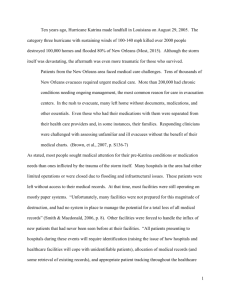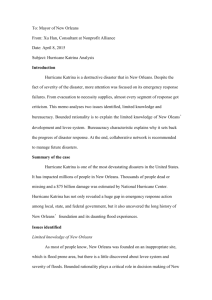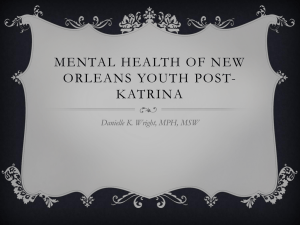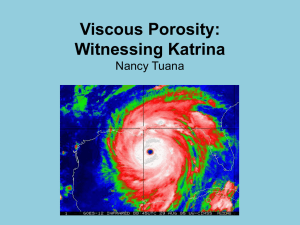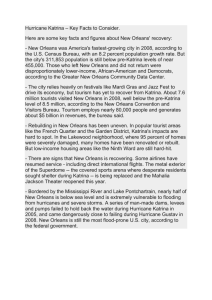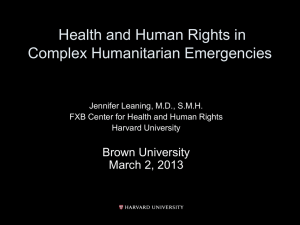Disaster Assessment
advertisement
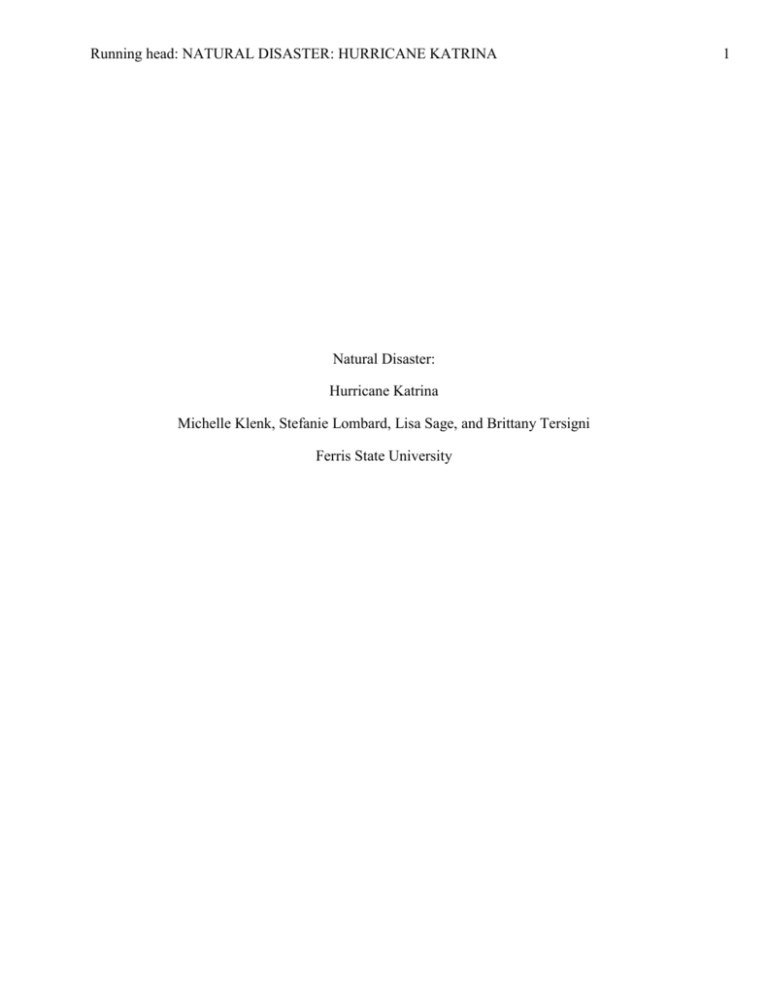
Running head: NATURAL DISASTER: HURRICANE KATRINA Natural Disaster: Hurricane Katrina Michelle Klenk, Stefanie Lombard, Lisa Sage, and Brittany Tersigni Ferris State University 1 NATURAL DISASTER: HURRICANE KATRINA Abstract In August of 2005 a devastating natural disaster struck New Orleans. Hurricane Katrina hit Louisiana with such force that the levees were breeched and the city flooded. Major hospitals in the area sustained severe damage, disabling them from helping those in need. Since Katrina, there have been numerous hurricanes that are listed as a category three or greater. Some of these made landfall within the United States causing severe damage. With the damage from these hurricanes come the threat of injury and even mortality. The health implications caused by the damage can be numerous, ranging from an exacerbation of chronic illness to mental disorders. Those who are affected the worst by hurricanes are the elderly and sick mainly due to lack of mobility. The Federal Emergency Management Agency (FEMA) has come up with many ways in which to minimize the risks associated with hurricanes and their devastating destruction. It is their goal to reduce the loss of both life and property during and after these events. Even though Hurricane Katrina brought about devastating destruction, it has taught us all something more about how nature can create such storms. With this knowledge we are able to prepare for future storms that are similar to Hurricane Katrina. 2 NATURAL DISASTER: HURRICANE KATRINA Natural Disaster: Hurricane Katrina When Hurricane Katrina hit Louisiana in 2005, it not only devastated the land it also destroyed and changed the lives of those involved forever. Over 1,100 individuals were killed during and or after the hurricane, while many others were injured. Unfortunately this is becoming a growing epidemic throughout the world. Hurricanes are gaining strength and causing more damage than in previous years. FEMA is now looking at different ways in which to prevent future destruction and death due to these violent storms. By doing so, there are hopes that we can be more prepared prior to these storms making landfall. No one was prepared for the amount of devastation and destruction that Louisiana felt after Hurricane Katrina. Hurricane Damages On August 29th, 2005 Louisiana and its surrounding areas were devastated by a category five storm with winds reaching speeds as high as 160 miles per hour. Prior to making landfall in Louisiana the hurricane was downgraded to a category three. Hurricane Katrina was one of the strongest storms ever to hit the coast of the United States. According to American Society of Civil Engineers: Hurricanes are intense low-pressure areas that form over warm ocean waters in the summer and early fall. As warm, moist air rises from the ocean surface into cooler air above, the water vapor condenses to form droplets and clouds. This condensation releases heat, boosting the rise of the air, lowering the central pressure, and drawing more warm, moist air into the storm. In this manner, the energy builds up and the wind speed increases. The low pressure causes wind to spiral inward toward the center of the low-pressure area, creating the hurricane (2006). 3 NATURAL DISASTER: HURRICANE KATRINA With the surges of wind inducing the motion of water, it reduced pressure of the storm and the timing of high and low tides causing havoc. According to the National Oceanic and Atmospheric Administration (NOAA) Hurricane Katrina produced waves approximately 100 feet high in the Gulf of Mexico. Those who survived the storm became a part of the largest mass migration in the United States since the Civil War. The deceased totaled 1,118 with 135 people still missing who are presumed to be dead. The sewage like waters caused increased incidences of gastrointestinal illness, skin infections, and upper-respiratory complications. Direct damage to residential and non-residential capital (commercial, industrial, and public buildings) reached approximately $21 billion, according to the American Society of Civil Engineers. Total employment in the New Orleans metro area plummeted 25 percent from 512,000 jobs to approximately 388,000 after September of 2005. As of June 2006, the population of New Orleans was still half of what it was prior to Hurricane Katrina. Almost every hospital in the New Orleans area was crippled in some way from the floodwaters. As of March 2006, only 456 staffed hospital beds were available, one-fifth the preKatrina number. Less than half the adult acute care facilities remained open. The Medical Center of Louisiana at New Orleans sustained the most amount of damage forcing them to close their doors. This left a significant gap in health-care services for Medicaid patients and the uninsured. It also and removed a Level I Trauma Center from the Gulf Coast region. Because many jobs were lost and businesses closed citizens of Louisiana lost their health benefits. Without health insurance many individuals are not seeking treatment or they are traveling to other surrounding medical centers. 4 NATURAL DISASTER: HURRICANE KATRINA The future recovery of Louisiana post Hurricane Katrina affects is still a mystery. Secretary Stephen Moret states "We're pleased with our recent progress, but our state needs to do more to position itself to outperform the South and the U.S. on a regular basis", (Louisiana, 2013). Ongoing efforts to re-build the state are happening as we speak. Areas with the least amount of damages are being worked on first and day to day life is being put back together by the locals. Hurricane Occurrences Many wonder if hurricanes are increasing in size and devastation or are there just more storms being produced. Global warming is an answer that seems to surface numerous times. A research study performed by the School of Earth and Atmospheric Sciences at Georgia Tech and the National Center for Atmospheric Research showed the number of category four and five hurricanes has doubled worldwide over the last 35 years. Since 1990 the total number of hurricanes though has dropped. The occurrence of category four and five hurricanes has grown from ten a year in the 1970’s to eighteen a year since 1990. In 2005, the year Hurricane Katrina struck, there were 31 tropical cyclones of which 27 were given names. There were four hurricanes that hit the United States, three of these were category five hurricanes (Eilperin, 2005). The disasters today are created by a mix of factors including routine climate change and global warming influenced by human behavior. These factors are playing a major role in the increasing events of hurricanes. Experts believe the world is in the midst of a routine climate change. The climate change causes the Caribbean to heat up and increase the frequency of powerful storms. This effect can be far greater than global warming (Braine, 2006). The 5 NATURAL DISASTER: HURRICANE KATRINA average tropical sea surface temperature has increased as much as one degree Fahrenheit during 1970 to 1990 (Eilperin, 2006). The question still remains if hurricanes are increasing or just gaining strength. Some blame global warming increasing the temperature in the ocean. Others believe the increase of hurricanes results from the natural change in climate. The climate change can last 30 to 50 years. If the reason for the increase is global warming, the increase in hurricanes will only grow in numbers throughout the coming years. Health Implications The effects of Hurricane Katrina were felt everywhere. With the levees breeched the city began to flood. As the flood waters rose, they began to take over waste disposal areas throughout the city. This spill caused sewage and other contaminates to enter the water and spread throughout the city. In addition, one of the major water mains ruptured in the city, causing the contaminated water to leak into the water lines of New Orleans. This flooding caused all types of health concerns both in the immediate time frame and months to follow. During this disaster many individuals feared the health implications that may happen due to flood waters and contamination. With the flooding came all new types of bacteria from the open water, leaving New Orleans with little to defend itself (Frank, 2012). The contamination brought on threats of typhoid, cholera, E. coli, hepatitis A, viral gastroenteritis, salmonella, and skin infections. The threat of West Nile from mosquitoes was another concern of Infectious Disease specialists. Once the waters began to recede, the threat of mold began to emerge. The different types of spores made this a huge threat to those who were working during the clean-up process. Respiratory complications became a concern also due to the mold and other 6 NATURAL DISASTER: HURRICANE KATRINA contaminates that could become airborne. Various forms of mental illness were another health concern that struck New Orleans after Hurricane Katrina. The contaminated flood waters brought on many problems for those in the New Orleans area. Hand washing is the best way to prevent disease, but even hand washing is difficult in the absence of clean water (DeNoon, 2005). Some people were able to boil water so that they could have something to drink and cook with. But for those without power, that was not an option. The only way that they could attempt to sterilize the water was to add small amount of chlorine bleach to the water and let it stand for thirty minutes (DeNoon, 2005). The lack of clean water made individuals vulnerable to heat-related illnesses and dehydration (Weaver, 2005). With so many individuals having to evacuate their homes, many were brought to shelters and offered support and care if needed. Inside these shelters many diseases were spread from one person to another due to the contaminated waters and the close proximity to those that were ill. When the contaminated flood waters receded it left numerous areas with growing mold. The furry fungi that thrive in damp environments, reproducing by means of spores covered carpets and walls in many homes and office buildings and has required the destruction of many structures already, and potentially many more (Wilson, 2006). It was thought that the mold was the most pressing respiratory contaminate post Hurricane Katrina. The Centers for Disease Control recommended the use of personal protective equipment for all individuals who were required to enter households for clean-up. Since mold carries many different allergens it can not only cause complications for healthy individuals, it can worsen problems for those who already have respiratory illnesses. In the course of demolition and clean up, many individuals came to Louisiana to help those who had lost everything. These workers were at risk for inhalation exposures to dust 7 NATURAL DISASTER: HURRICANE KATRINA containing microbial and other agents during demolition, remove, and repair of flood damaged and contaminated infrastructure and building materials (Freyder, 2012). Individuals with existing pulmonary complications found themselves with worsening symptoms and others developed a new onset of asthma like symptoms. In a study published by the Journal of Environmental and Public Health, 3.7 percent(n=791) of the cohort reported having pneumonia after Hurricane Katrina while 4.5 percent reported new onset of asthma (Freyder, 2012). Due to the exposure to microbial-contaminated dust and debris, those living and working in the Louisiana were at greater risk for developing various degrees of respiratory illnesses following Hurricane Katrina. Those individuals who stayed in the New Orleans area during the hurricane and survived now have many obstacles in which they have to face. Besides the obvious reasons of destruction and death, about half of the individuals now suffer from some type of mental illness. Survivors continue to suffer from poor mental and physical health for prolonged periods of time after the initial impact (Blackwell, 2008). Depression and anxiety are the highest listed mental disorders which survivors face. Some also relive the memories and suffer from Post-Traumatic Stress Disorder (PTSD). Unfortunately these mental health concerns were forced to the back burner causing many to never seek treatment or counseling for their condition. With everything that they had been through, having someone to talk to might have been the easiest thing that could have been done. When looking at the casualties from Hurricane Katrina there was a noted correlation for those that did not survive. Out of the 1,118 deaths over 60 percent of them were individuals over the age of 65. Two-thirds of the deaths were blamed on direct physical impacts from the flooding (drowning) while the other one-third was related to health conditions. The mortality 8 NATURAL DISASTER: HURRICANE KATRINA was noted to be higher in areas which were breeched by the levees and found to have the deepest waters. Those that stayed behind were found to be the ones who could either not get transportation out of the city or did not want to leave their personal belongings. When researchers looked further into the morbidity caused by Katrina, it was found that out of 829 victims 85 percent were over the age of 51. The elderly and disabled were the hardest hit populations when it came to casualties. Hurricane Katrina affected all individuals who worked in the healthcare system. The hurricane destroyed doctor's offices as well as area hospitals. This put many from the health care team out of work and unable to help others. Because of debris, healthcare workers from outlying areas were unable to gain access to facilities that needed help. In some of the shelters, facilities set up little 'satellite' medical stations where they were able to treat individuals who needed medical attention. Staff from these shelters found that they had to treat many individuals for acute and chronic illnesses. Since little supplies and medications were available they had to ration what they had to treat those who truly needed attention. Treating those patients in the shelters was difficult and often labor intensive without all the necessary medical equipment to perform the desired tasks. Prevention and Mitigation The size and devastation of Hurricane Katrina resulted in one of the biggest natural disasters in this nation’s history. It raised major questions about the nation’s readiness and overall ability to respond to such shattering disasters. The aftermath of Hurricane Katrina highlighted the many flaws in the hurricane protection and preparedness systems of New Orleans showing much needed room for improvement. New Orleans presents a unique and complex situation in regards to hurricane preparedness and planning due to the large areas and structures 9 NATURAL DISASTER: HURRICANE KATRINA across the city near or below sea level. At one time, modern protective structures were thought of as a fail proof measure to protect against the surge of a hurricane. Structures alone do not provide fail proof protection during this time. In the devastation of Hurricane Katrina, the weighty reliance on structures alone, led to the creation of a false security for those living, working or seeking to build areas behind such “safe” structures (National Academy of Engineering and National Research Council, 2009). The Federal Emergency Management Agency (FEMA), published a Best Practices book representing mitigation activities resulting from lessons learned after Hurricane Katrina. According to FEMA, it is an invaluable resource to communicate the importance of identifying hazard risks and ways to minimize risks, identify mitigation ideas to show how it is both effective and affordable, and to demonstrate how mitigation makes communities more stable and productive (FEMA, 2012). The Louisiana State University Agriculture Center (AgCenter) highlighted the need for Louisiana residents to learn more about mitigation and the rebuilding process. “Build Safer, Stronger, and Smarter” became the campaign theme for the Katrina recovery efforts. The unit has created mitigation task forces in fifteen southeast Louisiana parishes, bringing together local floodplain administrators and planners, AgCenter Extension specialists and nonprofit representatives from agencies to work and train others (FEMA, 2012). One way to reduce and avoid repetitive flood damage from hurricane surges was to build elevated homes. The key when building was to build at least two feet above the base water elevation, constructing an energy efficient home and making sure it was cost effective. Many residents in Louisiana were able to do this as it was made possible through a government based grant program called the Repetitive Flood Claims (RFC) grant, part of the Bunning-BereuterBluenauer Flood Insurance Report Act of 2004. Funds are provided to assist states and 10 NATURAL DISASTER: HURRICANE KATRINA communities to reduce flood damages to insured properties. Up to $10 million in funds are available annually for FEMA to provide RFC funds to assist those communities in need (FEMA, 2012). Another program through FEMA is the Hazard Mitigation Grant Program (HMGP) which pays up to 75 percent of the cost of approved public or private projects, which will prevent or reduce damage related to storms and other natural hazards. As part of the program, it aims to move residents and their homes away from danger and end the cycle of destruction (FEMA, 2012). Louisiana’s wetlands make up about 40 percent of the continental U.S. wetlands. These swamps and marshes provide a natural buffer against waves and storm surges, but after Katrina, 217 miles of marsh were transformed into open water. The AgCenter’s research program focused on the key components of saving the wetlands. The program’s primary objective was to develop improved varieties of plants used for the costal restoration. According to Carrie Knott, the assistant professor at the School of Plant, “Smooth cordgrass found in the salt marshes, has proven to be effective in slowing down surges and hurricanes. It is an ideal plant that spreads quickly and forms a dense canopy,” (FEMA, 2012). Another plant that has been noted as crucial for wetland restoration is sea oats. Knott said, “The beauty of the plants is that you can put them in, and after a few years huge sand dunes develop around them,” (FEMA, 2012). The program has explored several varieties of plants, and is the only program in the nation developing improved plant varieties for coastal restoration. Plants are the key to restoring natural ecosystems and saving the wetlands (FEMA, 2012). Drainage pump systems are a network of pumps that suck up flood water and divert it to a specified area. The electric powered systems start up automatically, and most have an automatic shut off system and backup generator. Although costly and requiring ongoing 11 NATURAL DISASTER: HURRICANE KATRINA attention, a pump motor generally lasts 10 years and can pump for about 20 years. The pumps have proven to be invaluable even when levels are well above the highest flood marks. For example, in one area 60 miles west of New Orleans, a parish just south of the Mississippi River had minimal damage from hurricanes Katrina and Rita as the pumps ensured the parish was protected. Jim Stark the former director of FEMA’s then-Transitional Recovery Office in New Orleans stated, “Drainage pump stations play a critical role in flood prevention,” (FEMA, 2012). In Louisiana, residents in cities of flood prone areas have had to deal with the sewage that backs up through drain pipes into homes and local businesses. Not only is this an unpleasant situation but can also pose serious health hazards. The requirement to install backflow valves protects homes from such sewer backups. The valves temporarily block the pipes preventing flow inside. The installation is simple for any plumber and inexpensive to homeowners, less than thirty dollars. All new construction is to have backflow valves according to the city’s ordinance (FEMA, 2012). Since the implementation of the valves in old and newer construction houses, a lot of damage has been prevented. New Orleans was changed forever when Hurricane Katrina hit. Those individuals who were fortunate to survive are now forced to pick up the pieces of their shattered lives. The presence of hurricanes throughout the world is on a rise. These storms are unpredictable, causing destruction and devastation along the way. We as a nation are learning more about these storms and creating ways to prevent further losses. As we gain this knowledge we will be better prepared for major hurricanes, and the thought of another Katrina will be non-existent. 12 NATURAL DISASTER: HURRICANE KATRINA References Andersen, C., Battjes, J., Daniel, D., Edge, B., & Espey, W. (2007). The New Orleans hurricane protection program what went wrong and why. Reston, VA: American Society of Civil Engineers. Blackwell, W. (2008). Hurricane Katrina increased mental and physical health problems in New Orleans by up to three times. Science Daily. Retrieved from http://www.sciencedaily.com/releases/2008/09/080903075614.htm Braine,T. (2006). Was 2005 the year of natural disasters? World Health Organization. 84(1), 180. DeNoon, D. (2005). What to expect, how to cope. WebMD Health News. Retrieved from http://www.webmd.com/news/20050831/hurricane-kartina-health-aftermath Eilperin,J. (2005). Severe hurricanes increasing, study finds. The Washington Post. Retrieved from http://www.washingtonpost.com/wpdyn/content/article/2005/09/15/AR2005091502234.html Federal Emergency Management Agency, FEMA (2012). Best practices- Promoting successful mitigation in Louisiana, post Hurricane Katrina. U.S. Department of Homeland Security. Retrieved from http://www.fema.gov/library/viewRecord.do?id=6722 Frank, B. (2012). The health effects of Hurricane Katrina. The Science Education Resource Center at Carleton College. Retrieved from http://serc.carleton.edu/NAGTWorkshops/health/case_studies/hurricane_Kartina.html 13 NATURAL DISASTER: HURRICANE KATRINA Freyder, L., Jones, R., Lefante, J., Rando, R. (2012). Respiratory health effects associated with restoration work in post-Hurricane Katrina New Orleans. Journal of Environmental and Public Health. 2012(462478), 1-8. Louisiana Economic Development. (2013). Louisiana’s strategy for the future. Retrieved from http://www.louisianaeconomicdevelopment.com/led-news/articles/louisiana's-strategyfor-the-future.aspx National Research Council. (2009). The New Orleans hurricane protection system: Assessing pre-Katrina vulnerability and improving mitigation and preparedness. Washington, DC: National Academies Press. Graumann, A., Houston, T., Levinson, D. (2006). Hurricane Katrina, a climatological perspective. Asheville, NC: National Oceanic and Atmospheric Administration. Weaver, J. (2005). Katrina health risks rise with flooding. MSNBC. Retrieved from http://www.nbcnews.com/id/9109689/ns/health-health_care/katrina-health-risks-riseflooding/ Wilson, J. (2006). Health and the environment after hurricane Katrina. Annals of Internal Medicine. 144(2), 153-156. 14
